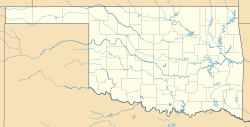Wheelock Academy facts for kids
|
Wheelock Academy
|
|
| Nearest city | Millerton, Oklahoma |
|---|---|
| Built | 1832 |
| Architect | Alfred Wright |
| NRHP reference No. | 66000949 |
Quick facts for kids Significant dates |
|
| Added to NRHP | October 15, 1966 |
| Designated NHL | December 21, 1965 |
Wheelock Academy was a very important school for girls from the Choctaw Nation. It was seen as a great example for other schools of the Five Civilized Tribes. These tribes were Native American nations that had adopted many customs of their European-American neighbors.
The school started in 1832 as a missionary school. It was specifically for Choctaw girls. Today, the Choctaw Nation still owns the land where the school once stood.
Wheelock Academy closed its doors in 1955. After it closed, the only other Choctaw school, Jones Academy, started accepting both boys and girls. This is called being coeducational. The old school site is about 3 miles (4.8 km) east of Millerton in McCurtain County, Oklahoma.
Contents
The Academy's Beginnings
The Wheelock Academy was started in 1832. A doctor and missionary named Alfred Wright helped create it. He also helped start the nearby Wheelock Church.
Alfred and his wife, Harriet Wright, traveled with the Choctaw tribe. The Choctaw people were forced to leave their homes in the southeastern United States. They had to move to a new area called Indian Territory.
Alfred Wright named the school after Eleazar Wheelock. Eleazar Wheelock was famous for starting a school for Native American students. This school later became Dartmouth College.
Within a year, people were already saying Wheelock Academy was a great example for Native American education. In 1839, Alfred Wright made the school bigger. He built a large building for students to live in.
In 1842, the school he started became the first official Choctaw national academy. Alfred Wright passed away in 1853. Reverend John Edwards took over as the head of the school. Harriet Wright left the mission soon after due to poor health.
School During the Civil War
Wheelock Academy had to close during the American Civil War (1861-1865). The American Board of Missions told Reverend Edwards to close the school and church. They told him to go back North.
Rebuilding the Academy
After the war, a man named Libby and his wife helped care for the buildings. Libby's wife had been a student at Wheelock before the war. They kept the school running as a day school.
However, a fire in 1869 destroyed many of the buildings. Classes still continued in the buildings that were not badly damaged. The Choctaw Nation worked to rebuild the school from 1880 to 1884. They got help from the Southern Presbyterian Church.
Even though other groups helped manage the school, the Choctaw Nation always owned it. They also helped pay for it.
In 1882, the Choctaw Council created a National School Board. This board decided to rebuild the damaged buildings. They wanted Wheelock to be a boarding school just for girls again.
Reverend John Edwards was asked to return as superintendent in 1884. He was not feeling well, so he suggested they find someone else. He still helped as a mentor until 1887.
Reverend William C. Robe became the next superintendent. His son, J. C. Robe, took over in 1890. From 1890, Wheelock Seminary was a "contract school." This meant the Choctaw Nation paid for the school. But the American Board of Missionaries provided the teachers and leaders.
What Students Learned
Girls attending the Choctaw academies were usually between ten and sixteen years old. When the boarding schools for girls first opened, students were given English names. They were told that all lessons would be in English. They were not allowed to speak their native language at school.
The girls learned important life skills. This included sewing, making clothes, and doing household chores. They also learned useful business skills.
Their studies included reading, writing, and spelling in English. They also learned math, music, and geography. Some schools even taught more advanced subjects. These included algebra, geometry, U.S. history, chemistry, and art.
The School's Final Years
A law called the Curtis Act of 1898 was passed in 1898. This law required all tribal schools to close slowly. It also said that tribal governments had to be ended before Oklahoma could become a state.
By 1930, Wheelock and the Jones Academy were the only Choctaw schools left. In 1932, Wheelock became a United States Indian School. In 1955, its operations were combined with Jones Academy. The Wheelock site then closed for good.
A Historic Landmark
The Wheelock Academy site was recognized as a National Historic Landmark in 1965. This means it is a very important historical place in the United States. It was also added to the National Register of Historic Places in 1966.
Wheelock Academy Today
Today, only seven buildings from the old academy are still standing. Most of them are in poor condition. Local people help take care of the grounds. One building, called LeFlore Hall, has been turned into a museum.
In 1999, news reports mentioned that the Choctaw Nation was working to restore the academy. All the remaining buildings had been painted and given new roofs. The full restoration was estimated to cost a lot of money.
The Choctaw Nation hoped to turn the restored academy into a college. This would be the first college owned by a tribe in Oklahoma.
However, a report to Congress in 2001 listed Wheelock Academy as a "Threatened Landmark." The report said that the buildings were falling apart. It also mentioned that people were stealing things and damaging the site.



